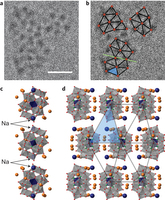
- Details
- Thursday, 12 January 2017

How molecules in solution form crystal nuclei, which then grow into large crystals, is a poorly understood phenomenon. The classical mechanism of homogeneous crystal nucleation proceeds via the spontaneous random aggregation of species from liquid or solution. However, a non-classical mechanism suggests the formation of an amorphous dense phase that reorders to form stable crystal nuclei. So far it has remained an experimental challenge to observe the formation of crystal nuclei from five to thirty molecules.
Here, using polyoxometallates, we show that the formation of small crystal nuclei is observable by cryogenic transmission electron microscopy. We observe both classical and non-classical nucleation processes, depending on the identity of the cation present. The experiments verify theoretical studies that suggest non-classical nucleation is the lower of the two energy pathways. The arrangement in just a seven-molecule proto-crystal matches the order found by X-ray diffraction of a single bulk crystal, which demonstrates that the same structure was formed in each case.
Read more here
